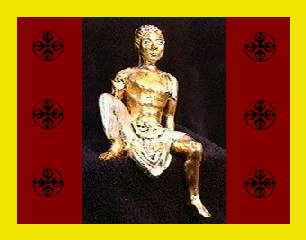

return to Winter 1997 (#31): EXERCISES IN SPIRITUALITY
The above photo is of a sculpture by
KIP DOLLAR
of the Bodhisattva Avalokitesvara as a modern gay man.
An ancient Mahayana Buddhist myth tells of a fellow who had worked his way through countless incarnations to become a bodhisattva, a stage of development just before becoming a buddha. In what promised to be his final incarnation, he was a young, beautiful, kind, gentle, and androgynous being called Avalokiteshvara whose name means "The Lord Looking Down in Pity." As he was entering his final meditation, about to achieve his goal of lifetimes beyond number, he heard a groan go up from all around him. He came out of his meditation and asked, "What's this about? I was about to achieve Nirvana. Why the groan?"
All of nature answered in a single voice, "0 Avalokiteshvara, we are happy for you that you are about to enter Nirvana, but we are sad for ourselves. Life is hard and full of suffering. What's kept us going was the thought of you. You are so kind and lovely. You've been a source of strength and inspiration for us. Now you are about to leave us, and so we groan."
Rapt with compassion, the young saint responded, "Well, then I won't leave you, but shall renounce my own Nirvana until all sentient beings are likewise enlightened." Indeed, he went on to say, "It would be better for one to suffer than for all. Therefore I vow to take upon myself all the karma and all the suffering of all sentient beings. I shall remain in the cycles of reincarnation until the end of time bestowing grace and mercy for the good of all."
According to one interpretation of the myth, when Avalokiteshvara made his great vow, all other sentient beings were at that moment ushered into Nirvana, leaving Avalokiteshvara alone behind to live out all their karma for them. This androgynous being then is the only being who is incarnating. And though we all think ourselves to be different, separate individuals -- all fighting, struggling, conquering, or succumbing to the exigencies of our unique karmas --indeed, we are each and all really manifestations of that one being, Avalokiteshvara, living out the vow and discovering that this is what Nirvana really is: not the renunciation of the world, but the loving, compassionate embrace of all possible human experience. Thus the name Avalokiteshvara can also be interpreted "The Lord Who is Seen Within."
Of course, this Buddhist myth from the first or second century of the Common Era is not about homosexuality and gay identity as we know them in the twentieth century (tho' one has to wonder if homosexually-oriented Buddhist monks all the down the corridors of time haven't found in it, at least in the depths of their meditations, a confirmation of central feelings in their lives). But the character in the myth reminds us today of what are thought of as gay traits. Avalokiteshvara's sensitivity and generosity, his lovableness and sweetness, his attractiveness and youthful vitality and pluckiness reflect characteristics that certainly aren't limited to gay men--and aren't even necessarily honored in popular gay culture or portrayed in the gay erotic media. Nonetheless, these qualities shine forth from so many gay men in the acquaintance of us all. It is, indeed, the appearance of such traits that justifies our speaking about "gay men's spirituality."
It is said there are Three Wonders of the Bodhisattva to meditate upon. The first is that the Bodhisattva is simultaneously male and female, transcending the polarities, like the Two-Spirit persons of Native-American (and pop gay) lore. Sometimes Avalokiteshvara is portrayed icongraphically as male on the right side of the body and female on the left.
The second wonder is that from the Bodhisattva's perspective there is no distinction between life and release-from-life, between samsara and Nirvana no ascer-tainable difference: time and eternity are one. In the jargon of the New Age: "This is IT," no difference between now and life-after-death, no distinction between the longing for God and the experience of living life, no goal to achieve.
And the third wonder is that the first two are the same. Transcending the polarities of male and female is a necessary step in achieving enlightenment and a contribution to the evolution of consciousness.
The goal of religion and spiritual-seeking, after all, isn't to get to heaven after practicing unspeakable mortifications and penances in this life, but to discover, honor, relish and enjoy one's place, beyond the limits of individuality and the accidents of personality, as embodied in the divine process here and now. This is Heaven.
Toby Johnson